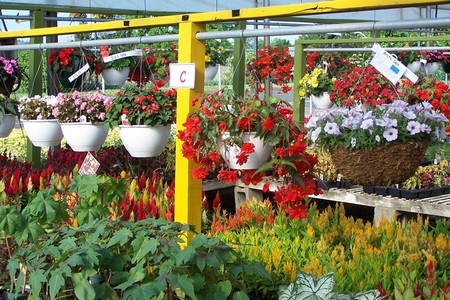Hanging-baskets create spectacular displays throughout the summer. They are formed of flowering and attractively-foliaged plants, in color mixtures or as single-color themes, and will brighten drab doorways, windows and walls.
Each year, seed companies introduce new varieties of flowers for planting in hanging-baskets. These plants vary in size, shape and color, but all have several important qualities:
- They must be able to flourish in small amounts of compost and, preferably, not be exceptionally invasive of their neighbours.
- Preferably, those that flower should be in bloom when planted in late spring or early summer.
- They must respond well to regular feeding, from mid- to late summer, which encourages the continuing development of flowers.
- Plants must not be susceptible to pests and diseases. For example, although trailing nasturtiums are attractive, they invariably attract black-fly.
Clues to selecting plants
Single-color hanging-baskets create dominant displays, but ensure they harmonize with their background.
In mixed baskets, combine foliage plants with flowers. Many foliage plants are better able to survive adverse weather than flowering types.
Keeping plants healthy
To keep hanging-baskets attractive, plants require daily attention throughout summer.
- If baskets are put outdoors too early, and a light frost is forecast, place several layers of newspaper over the plants.
- Water the compost every day -sometimes twice – during hot weather.
- Feed plants every ten to fourteen days when they are established and growing strongly. Add fertilizer to the water when watering plants, but first ensure that the compost is moist.
- Pinch off dead or faded flowers as they appear, to encourage the development of further blooms.
How to Plant
- Place a wire-framed hanging-basket in the top of a bucket to hold it firm while being planted. Line the basket with black polythene and mould it to the basket’s shape; cut it off 5-7.5cm (2-3in) above the rim. Later, it will need re-trimming.
- Place a handful of moist peat in the base, then add and firm a proprietary hanging-basket compost to about half the basket’s depth. Make 5cm (2in) long slits in the plastic, about 10cm (4m) apart and level with the surface of the compost.
- Push the roots of trailing plants through the slits, spread them and lightly cover with compost. Then, plants can be placed in the basket’s top. Put a dominant, cascading plant in the centre; check that the top of its soil-ball is 12-18mm below the rim.
- Position further trailing plants around the central plant, again with their tops below the rim. Cover and firm compost around the soil-balls, so that the surface is 12mm below the rim. Cut the plastic level with the rim and thoroughly water the compost.
- Form a thin layer of sphagnum moss over the surface; this creates an attractive foil for the plants and helps to prevent compost being washed over the sides when the basket is watered. Again water the compost. If the risk of frost has passed, suspend the basket outside.
Categories
Advertisements
Recent Articles
 How to Understand Bed Sizes – A Small Guide
How to Understand Bed Sizes – A Small Guide How to Select Some Must Have Kitchen Accessories
How to Select Some Must Have Kitchen Accessories Best Way to Change a Car Tire
Best Way to Change a Car Tire Best Way to Write an Affirmation
Best Way to Write an Affirmation Best Way to Take Charge of Your Financial Life
Best Way to Take Charge of Your Financial Life Best Way to Survive a Party When You Don’t Know Anyone
Best Way to Survive a Party When You Don’t Know Anyone Best Way to Stop Self Sabotaging Yourself
Best Way to Stop Self Sabotaging Yourself Best Way to Start Journal Writing
Best Way to Start Journal Writing Best Way to Speak with a Powerful Voice
Best Way to Speak with a Powerful Voice Best Way to Simplify Your Life
Best Way to Simplify Your Life Best Way to Respond to a Put-Down
Best Way to Respond to a Put-Down Best Way to Reduce Acne Breakouts
Best Way to Reduce Acne Breakouts Best Way to Recover from Dining Disasters
Best Way to Recover from Dining Disasters Best Way to Quit Your Job Gracefully
Best Way to Quit Your Job Gracefully Best Way to Make Your Own Website
Best Way to Make Your Own Website




Leave a Reply